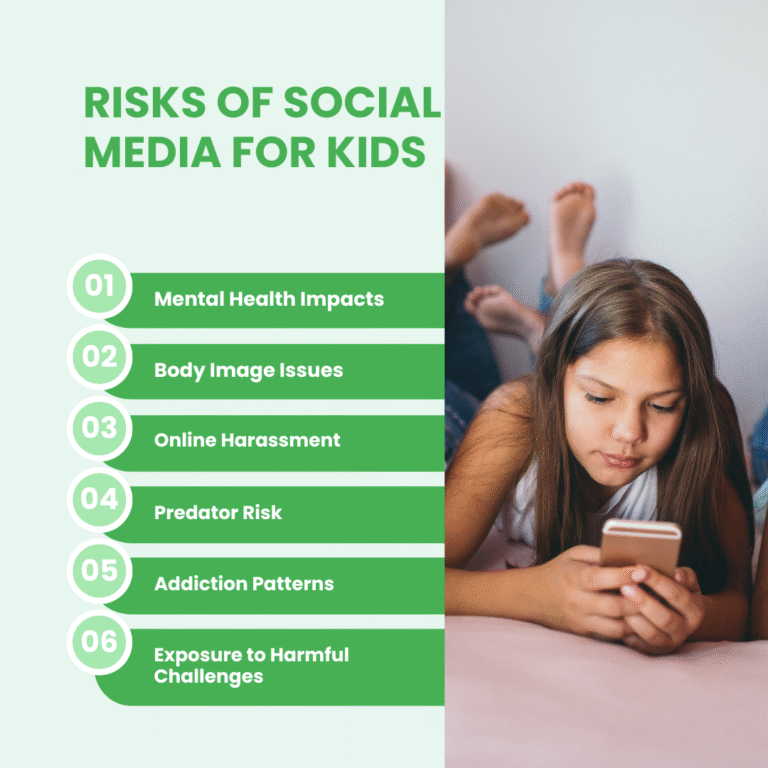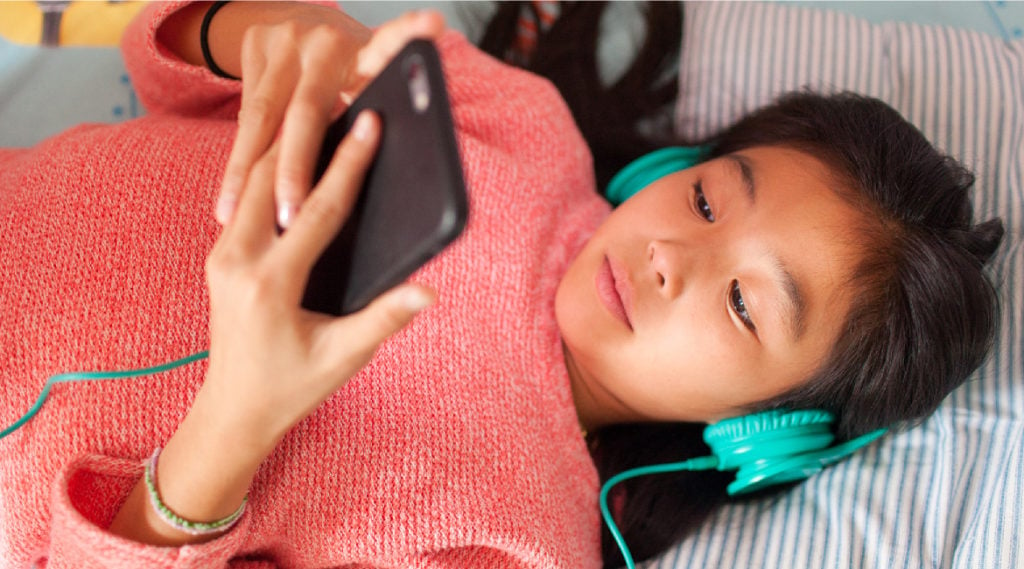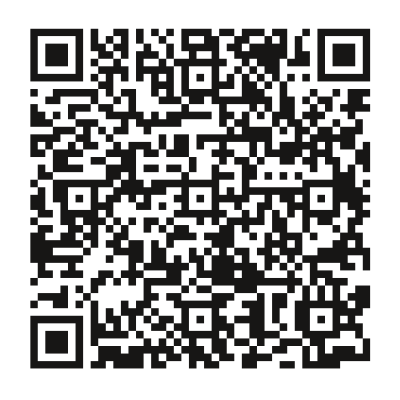Last year, a 12-year-old in Tennessee died attempting a dangerous “blackout challenge” discovered on TikTok. This tragic case isn’t isolated. Children’s social media use has skyrocketed, with the average American tween now spending nearly 5 hours daily on screens, and teens approaching 8 hours—not including schoolwork.
Kids are getting smartphones younger than ever. A 2023 Common Sense Media survey found 40% of children have social media accounts by age 10, despite most platforms’ official age minimum of 13.
This isn’t about creating panic or suggesting all technology is harmful. It’s about understanding what our kids face online, recognizing potential dangers, and finding practical solutions that work for your family. Throughout this guide, we’ll explore what platforms kids use, the real risks they face, and concrete steps you can take to keep them safe while still allowing appropriate digital exploration.
What Platforms Kids Are Using (and Why)
Ages 6-9
- YouTube Kids: Curated videos with parental controls, though content quality varies widely
- Roblox: Gaming platform with social features where kids create avatars and play together
Messenger Kids: Facebook’s messaging app designed for children with parent-approved contacts
Ages 10-12
- TikTok: Short-form videos that use powerful algorithms to keep kids scrolling
- YouTube: Full access to all content, including creator communities and comment sections
Snapchat: Messages and photos that disappear, making parental oversight difficult
Ages 13-16
- Instagram: Photo and video sharing with heavy emphasis on likes and followers
- Discord: Chat platform popular with gamers, featuring public and private servers
- Snapchat: Continues to dominate with features like location sharing and Stories
Children gravitate to these platforms for simple reasons: their friends are there, the content feels personally relevant, and the interfaces are designed to be addictive. Social media companies employ sophisticated psychological techniques—variable rewards (like slot machines), social validation through likes, and personalized content feeds—that trigger dopamine releases in developing brains.
The most concerning aspect? These platforms aren’t just entertaining kids—they’re engineered to maximize “engagement time” through algorithms that learn exactly what keeps each child watching longer.
Risks & Harms: What Parents Should Know

Social media’s impact on children goes beyond just “screen time” concerns. Here’s what research from the American Psychological Association, U.S. Surgeon General, and pediatric experts reveals:
Mental Health Impacts: Children who spend more than 3 hours daily on social media show significantly higher rates of anxiety and depression. The constant comparison to others’ highlight reels creates feelings of inadequacy, while the pressure to maintain an online presence adds stress to already challenging developmental years.
Body Image Issues: Filters and edited images create impossible beauty standards. A 2022 study found 78% of teen girls reported feeling worse about their appearance after using Instagram. Boys aren’t immune either, with increasing rates of body dissatisfaction linked to fitness and appearance content.
Cyberbullying & Online Harassment: About 37% of young people experience cyberbullying, with effects often more severe than traditional bullying because:
- It can happen 24/7
- Humiliating content can spread instantly to large audiences
- Messages can be anonymous
- Content can be permanently online
Predator Risk: One in five children who use social media report being contacted by strangers who made them uncomfortable. Predators often use information shared publicly to build false connections with children.
Addiction Patterns: The same brain circuits activated by gambling and substances respond to social media notifications. Many children display withdrawal-like symptoms when devices are removed.
Exposure to Harmful Challenges: Dangerous viral challenges spread quickly among young users seeking attention and validation, often before parents become aware of the risks.
5 Warning Signs of Unhealthy Social Media Use
- Sleep disruption or using devices late at night
- Withdrawal from in-person activities previously enjoyed
- Anxiety or distress when unable to access social media
- Declining grades or inability to complete homework without checking devices
- Secretive behavior about online activities
The Legal & Global Policy Landscape
Governments worldwide are responding to growing concerns about children’s social media use, though approaches vary dramatically:
United States: The Children’s Online Privacy Protection Act (COPPA) prohibits collecting data from children under 13 without parental consent—which is why most platforms set 13 as their minimum age. However, enforcement is minimal, and age verification is typically just a checkbox.
Several states have introduced stronger measures:
- California’s Age-Appropriate Design Code requires platforms to consider child safety in their design
- Utah passed laws requiring parental consent for minors to use social media
- Florida recently banned social media accounts for children under 14
United Kingdom: The UK has implemented some of the world’s strongest protections through its Online Safety Bill, including:
- Mandatory age verification
- Limits on addictive features for users under 16
- Requirements for platforms to protect children from harmful content
Australia: Australia has proposed banning YouTube and TikTok for users under 16 and is considering a national ID verification system for social media access.
This patchwork of regulations highlights a global recognition of the problem, but also creates confusion for parents trying to understand what protections actually exist for their children.
The Parent's Action Plan: How to Guide, Not Just Restrict
A. Set Healthy Digital Habits
Create a family media plan that works for your household’s values. Consider:
- Age-appropriate time limits (pediatricians recommend no more than 1-2 hours of recreational screen time daily)
- Device-free zones like bedrooms and dinner tables
- “Sunset rules” where devices are turned in 1-2 hours before bedtime
- Weekend vs. weekday differences
Model healthy behavior yourself. Kids notice when parents are constantly on phones during family time.
B. Have Open Conversations
Regular, non-judgmental talks about online experiences help children develop critical thinking skills. Try these conversation starters:
- “Show me your favorite YouTuber and tell me why you like them.”
- “Have you seen anything online that made you uncomfortable?”
- “Do you think people act differently online than in real life? Why?”
Teach children to recognize manipulation tactics:
- How to spot fake news and misinformation
- Why companies want their attention
- Warning signs of someone trying to build inappropriate relationships
C. Use Technology to Your Advantage
Parental controls aren’t about spying—they’re safety tools that provide peace of mind while teaching responsible digital citizenship.
The MMGuardian Kids Phone offers comprehensive protection through:
- Content filtering that blocks inappropriate websites and apps
- Safety alert message monitoring that notifies parents of potential cyberbullying, sexting, or predatory language.
- Screen time management with scheduled access periods
- Location tracking for safety
- Emergency lockdown capabilities
Unlike basic parental controls built into devices, MMGuardian works across platforms and apps, providing consistent protection whether your child is using social media, messaging, or browsing.
Other popular options include:
- Bark: Monitors content but doesn’t offer the same device management features
- Qustodio: Good for multiple devices but less advanced AI detection
- Google Family Link: Free but limited to Google ecosystem
D. Coordinate With Other Parents and Schools
Create a united front:
- Talk with parents of your child’s friends about shared social media rules
- Support school policies on devices and social media
- Join parent groups focused on digital citizenship
- Advocate for media literacy education in your school district
Age-by-Age Best Practices
Ages 6-9
At this age, children should have minimal, highly supervised exposure to social media:
- Use only curated platforms designed specifically for children
- Watch videos together and discuss content
- Focus on creative apps rather than social platforms
- Keep devices in common areas, never in bedrooms
- Use kid-friendly browsers with strict content filters
Ages 10-12
This transitional age requires increasing guidance:
- Consider a basic phone with limited features before jumping to a smartphone
- If using social media, start with family-oriented platforms where you can connect
- Review privacy settings together and explain why they matter
- Establish clear time limits and content boundaries
- Begin conversations about digital footprints and online reputation
Ages 13-16
Teens need more independence but still require guardrails:
- Gradually introduce mainstream platforms with ongoing monitoring
- Create a social media agreement with clear expectations and consequences
- Teach critical evaluation of content: “Is this real? Why was it shared? How does it make you feel?”
- Discuss the permanence of online actions and potential future impacts
- Check in regularly about online experiences without judgment
Resources & Expert Recommendations
For Parents:
- Common Sense Media (commonsensemedia.org): Age-based reviews of apps, games, and media
- Family Online Safety Institute (fosi.org): Tools and guides for digital parenting
- U.S. Surgeon General’s Advisory on Social Media and Youth Mental Health: Comprehensive overview of current research
For Children:
- MediaSmarts (mediasmarts.ca): Kid-friendly media literacy resources
- Be Internet Awesome (beinternetawesome.withgoogle.com): Google’s digital citizenship program
- NetSmartz (missingkids.org/netsmartz): Safety resources from the National Center for Missing & Exploited Children
Mental Health Support:
- National Alliance on Mental Illness Helpline: 1-800-950-NAMI
- Crisis Text Line: Text HOME to 741741
- Child Mind Institute (childmind.org): Resources on technology and mental health
Empowered Parenting in a Digital Age
Social media isn’t inherently good or bad—it’s a tool that can connect, educate, and inspire when used thoughtfully. The goal isn’t to eliminate technology from children’s lives but to help them develop healthy relationships with digital spaces.
The most effective approach combines open communication, clear boundaries, and appropriate technological safeguards like those provided by MMGuardian Kids Phone. This layered strategy helps children gradually build the skills they need to navigate online spaces safely.
Remember that you know your child best. Trust your instincts about what they’re ready for, be willing to adjust your approach as they grow, and keep the conversation going. With your guidance, children can learn to use social media as a positive force in their lives rather than being used by it.






